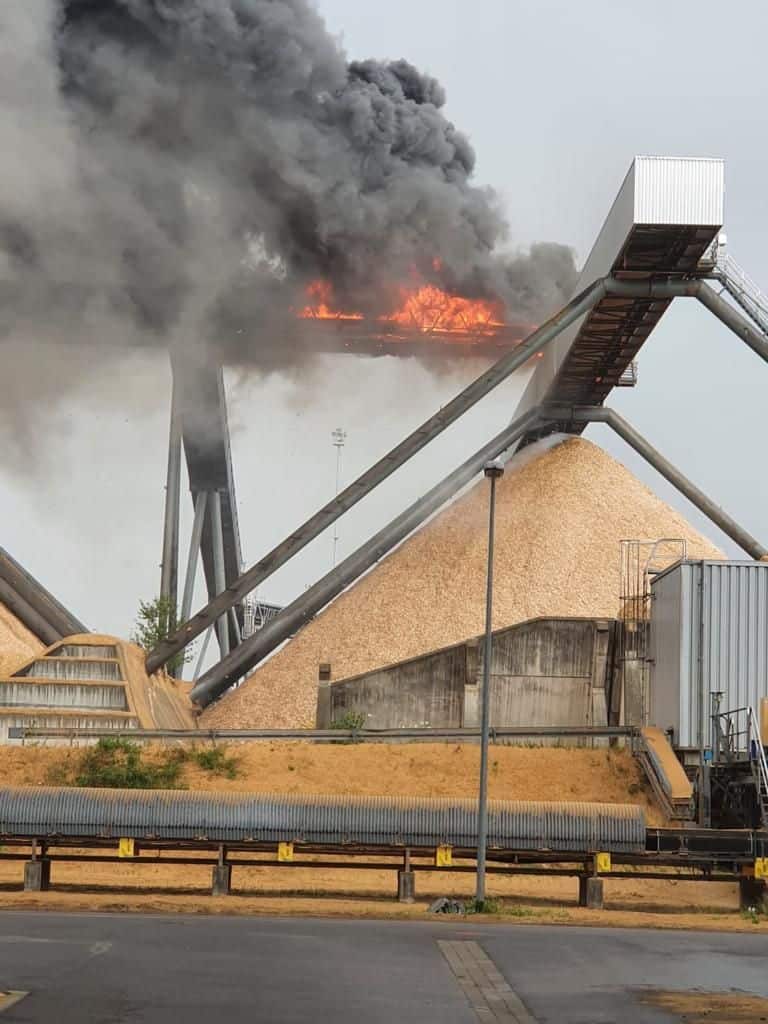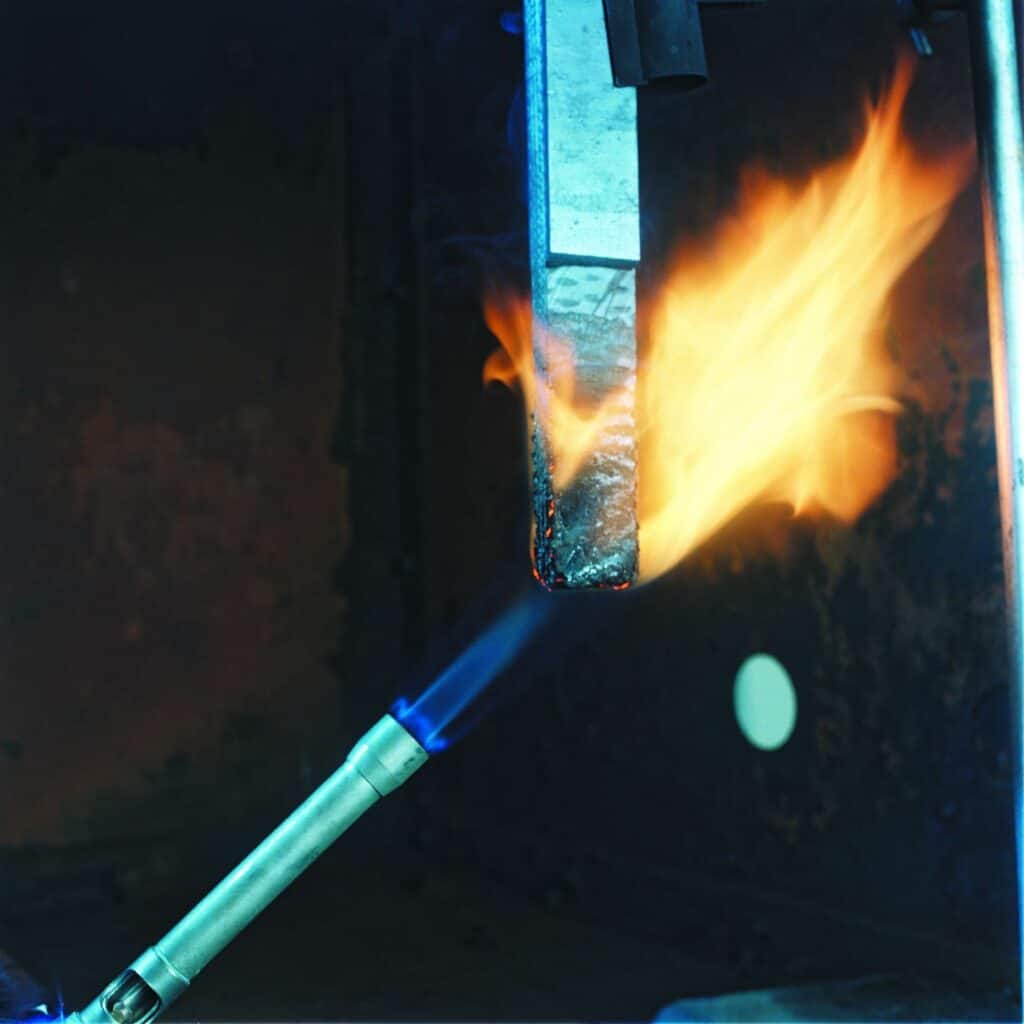Cost before safety?
I would like to think that no one would be irresponsible enough to put cost before safety and buy fire resistant conveyor belts that they suspect might not be up to the job. To be fair, choosing fire resistant belts is no easy task. Safety classifications and standards relating to conveyor belts can be confusing while sadly at the same time, many belt manufacturers and traders can be more interested in winning the order. In reality, the chances of a belt catching fire are pretty slim so the risk might be seen to be worth taking. However, the fact remains that there can be a very significant difference in the level of fire protection provided by belts supplied by different manufacturers even though they might technically claim to meet the same safety specification.
No conveyor belt is fire proof
The vast majority of conveyor belts used in ports and terminals are rubber multi-ply construction. The first thing to bear in mind is that rubber conveyor belts can never be totally fire proof. Rubber is flammable, full stop. Secondly, the fabrics used in the carcass of multi-ply belts are mostly polyester and nylon, which have virtually no resistance to fire. Consequently, every belt will burn when exposed to a naked flame that is sufficiently energized to cause it to ignite.

The two most frequently used descriptions relating to fire safety used for conveyor belts are “fire retardant” and, most commonly of all, “fire resistant”. In truth, a better and more accurate description would be “self-extinguishing”. This is because the ability of a rubber conveyor belt to ‘resist’ fire is actually achieved by adding special chemicals and additives to the rubber compound during the mixing process. Once the rubber has been vulcanised and is ignited it emits gases that effectively suffocate (extinguish) the fire by starving the flames of oxygen.
Different recipes or ‘cocktails’ of rubber compound are necessary depending on the level (standard) of fire resistance required. However, the chemical additives are very costly so if low grade or insufficient quantities of the additives are used in order to keep the selling price artificially low then the ability of the belt to self-extinguish will be slower and less effective than it could and should be. The time it takes for a belt to self-extinguish is enormously important for two reasons. Firstly, conveyors are frighteningly effective when it comes to conveying fire. Secondly, burning rubber and synthetic materials such as polyester and nylon release a dangerous thick smoke that contains cyanide, carbon monoxide, sulfur dioxide and products of butadiene and styrene, which therefore needs to be kept to an absolute minimum. This means that literally every second counts.

Standards and test methods for above ground applications
The basis of most tests for belting used in normal industrial applications is EN ISO 340 and is included within the classifications of EN 12882 on electrical and flammability safety requirements for general purpose conveyors used above ground. These standards make the distinction between fire resistance with covers, which is Class 2A (K grade) and fire resistance with or without covers, which is Class 2B (S grade). The relevance of “with or without covers” is that surface wear gradually reduces the amount of fire resistant rubber that protects the internal flammable carcass. Although no longer referred to in the current EN ISO 340, the market still commonly refers to grades ‘K’ for testing with covers and ‘S’ for testing with and without covers.
EN/ISO 340 testing
EN/ISO 340 tests involve exposing six individual samples of belt to a naked flame causing them to burn. The source of the flame is then removed and the combustion time (duration of flame) of the test piece is recorded. A current of air is then applied to the test piece for a specified time after the removal of the flame. The flame should not re-ignite.

The time it takes for the belt sample to self-extinguish after the flame has been removed is then measured. The duration of continued burning (visible flame) should be less than 15 seconds for each sample with a maximum cumulative duration of 45 seconds for each group of six tests. This means that the average allowable time per sample is 7.5 seconds. This factor is of paramount importance because it determines the distance that the fire can be effectively carried by a moving belt.
Even if a manufacturer states that their fire resistant belt has passed the ISO 340 test, the buyer should still exercise caution. A typical conveyor belt can easily travel more than 40 meters within the 15 seconds that is allowable for a belt sample to pass the test, which is a potentially very dangerous distance. For this reason, one major manufacturer (Dunlop in The Netherlands) applies an average maximum time limit standard of only one second, which is more than six times faster than the required standard and decidedly safer as a consequence.
Choosing the correct standard of fire resistance
Establishing the correct level or standard of fire resistance needed for conveyors operating in the open air is relatively straightforward. EN 12882 is the standard for safety requirements for conveyor belts for general-purpose use. The most basic safety requirement is EN 12882 Category 1, which simply demands that the belt is anti-static and conforms to EN ISO 284 international standards. For the vast majority of applications, EN 12882 Class 2A (K grade) or Class 2B (S grade) levels of fire resistance would be perfectly adequate. As described earlier, Class 2A demands that the belt is able to pass the ISO 340 test with the covers intact on the belt samples whereas Class 2B requires that the belt is able to pass the test with the top and bottom cover rubber removed. Both Class 2A and 2B fulfill the anti-static requirements of ISO 284.
The best way to decide between Class 2A and Class 2B is to consider the material being carried. For moderately abrasive materials, such as grain for example, then Class 2A is usually perfectly adequate. However, if the material is abrasive and tends to wear the top cover quite rapidly then the safest option is be to choose the Class 2B.

For materials that contain oil such as wood chips and biomass, rubber compounds that have a combined resistance to fire, abrasion and oil are available. This is yet another important consideration when deciding on the correct type of fire resistant belt so it is important to be very specific when making requests for quotations from manufacturers and suppliers.
Environments with inflammable dust and gas
For environments where coal dust, fertilizer, grain or other potentially combustible materials such as biomass are present, it is essential that the conveyor belt cannot create static electricity that could ignite the atmosphere. Belts need to be able to allow static electricity to pass through the metal frame of the conveyor structure down to earth rather than allow static to build up. The safest approach is for all belts to be anti-static and conform to EN/ISO 284 international standards. This means that they can all be used in ATEX 95 (94/9/EC Directive) classified zones.
Handling biomass
One of the biggest dangers concerning belts that carry biomass is dust emission and the prevention of explosion. In the production process of biomass wood pellets, wood chip and similar renewable resources, the materials are continually broken down. This results in high levels of dry, combustible dust that can be ignited by static electricity created by abrasion within the conveyor system because the source only requires ignition energy as low as 17mJ.

Biomass dust can also be prone to self-ignition, especially if the material has become damp. A chemical reaction can take place that causes self-heating and what is referred to as “off-gassing” (carbon dioxide, carbon monoxide and methane emissions).
Because of the increased risk of self-ignition, the use of covered conveyors is becoming increasingly commonplace. In enclosed environments, the risk to life is heightened because of the dangerous smoke that I referred to earlier. For this reason, EN 12882 Class 4A is usually the best choice for conveyors operating in closed or covered conditions because it involves a more severe fire test according to EN12881-1 method A, C or D in addition to EN/ISO 340 testing.

Check the provenance
The majority of conveyor belting used in Europe is imported from South East Asia, the vast bulk of which is from China. As with the approach they use for virtually every other market, the strategy is based on mass volume manufacturing at a barely acceptable (and often unacceptable) standard of quality at hugely subsidised prices. To be fair, their primary focus is routine abrasion resistant belting, which forms the bulk of the market rather than ‘specialist’ belts such as fire resistant for which there is a much lower demand.
This may well be one reason why random laboratory testing of imported belt consistently reveals serious shortcomings concerning fire safety. One such test recently revealed a dangerously low level of fire resistance. Although the duration of continued burning (visible flame) should be a maximum of 15 seconds per sample with a maximum cumulative duration of 45 seconds for each group of six samples, one set of samples taken from a fire resistant belt manufactured in China took 102 seconds to self-extinguish.

Fire resistant conveyor belts really can be a matter of life and death. In my opinion it is far safer to use well known European manufacturers such as Dunlop Conveyor Belting and Continental who have well-founded reputations for producing belts of much higher quality and safety standards. They are also much more able to provide technical support and advice. More expensive? Almost certainly yes. But a significantly lower price per meter should set the alarm-bells ringing just as a real life fire would do. As with just about anything in life, you get what you pay for. The cost of a fire resistant conveyor belt that does not self-extinguish fast enough, or perhaps not all, is almost impossible to calculate. Every second really does count
Leslie David
About the author:
After spending 23 years in logistics management, Leslie David has specialised in conveyor belting for over 17 years. During that time, he has become one of the most published authors on conveyor belt technology in the world.









































